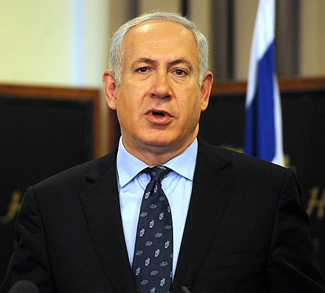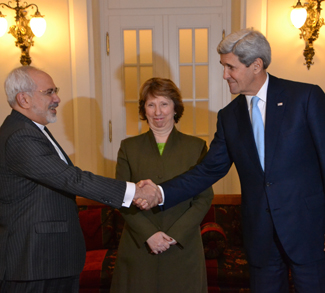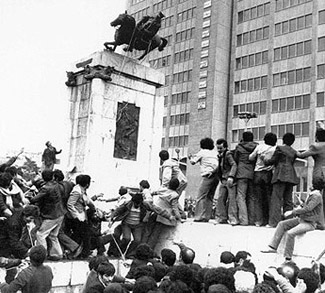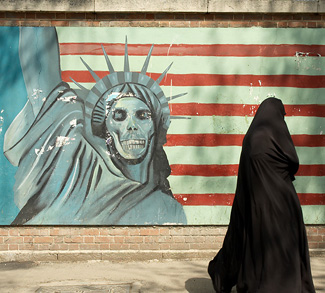Despite Israel’s vocal opposition, genuine fear, and preemptive threats, the truth is that Jerusalem understands Iranian nuclear weapons are an eventual fait accompli.
Atomic weapons technology is now 60 years old – just shy of Israel’s own age and a historical “classmate” of the Holocaust. It is almost inevitable that technology as old as rotary telephones is now within the grasp of backwards but determined fundamentalists.
For all his foreign policy debacles and earned “feckless” reputation, consider also that President Obama displayed a rare Realist insight into state behaviour as he approached Tehran with an aim to manage the Ayatollahs’ ambitions.
The fact that there is no trust between Obama and Israel’s Netanyahu just underscores and sensationalizes the fact that the “genie is long out of the bottle.”
The Iranian drive to nuclear weapons is no doubt wrapped in visions of the Mahdi and Zion in flames. Still, the even more “fundamental” and conservative vision of the regime is self-preservation.
Foremost, the deal gives Tehran relief from sanctions and domestic unrest in exchange for Western verification, a reduction in centrifuges, and limits on plutonium enrichment. True, a “bomb in the basement” also allows Iran to poke Israel further via Hezbollah and Syrian adventures and to challenge Saudi Arabia in the endless Shia-Sunni stalemate (a conflict that pre-dated ISIL and will survive it).
However, the Iranians are not victims of their own rhetoric. Their logical “use” of nuclear capabilities is limited to a deterrent against those who would thwart their regional ambitions. It is improbable, albeit not impossible, that Iran thinks it can destroy Israel and survive.
Far more important, the Ayatollahs’ pledge to lose half of their own country to destroy Israel underscores ambition more than observed behaviour. A suicidal Iranian regime does not need nuclear weapons to achieve national martyrdom. Chemical arsenals attached to Iran’s formidable ballistic missile force would trigger the same Armageddon and create innumerable Shaheed. There are softer targets for Iran of greater strategic value. Yemen and Iraq beckon, the latter with tacit Western encouragement. Jihad against the Zionists is a low-intensity conflict Iran controls via Hezbollah with little danger to itself (a fact not lost on the average Lebanese).
Israel, of course, understands this. Jerusalem, too, is a conservative power. Israel has no further territorial ambitions and seeks to retain the status quo. Control of the West Bank is both a security and ideological driver, undercut by the demographic math.
One of the greatest miscalculations strategists make in analysis of Israel’s behavior and intent is the assumption that the Palestinian question dominates Israeli considerations. It doesn’t. Israel wants quiet. Whether that is achieved by “occupation” or via “territorial concession” is just a tactical consideration.
For quiet to prevail, Israel is much more alert to Iran, Lebanon and Syria than Palestine. The Arab Spring served to further degrade the capabilities of conventional threats from border states. Iran, which emerged as a regional power after its war with Iraq in 1988, now lurks ominous in 2015.
For a time, Israel pondered in vain the logistics of how even its vaunted air force could overfly hostile neighbors then penetrate Iranian nuclear facilities constructed at levels far beyond those the IAF destroyed at Osiraq in 1981, or Syria in 2007.
At some point, Israeli planners concluded that it was just as hard for Iran to issue a direct threat to Israel as it was for Israel to reach Iran. In a slow but deliberate manner, Israel’s doctrine of preemption transformed to a more conservative and confident “active deterrent” posture. This is not to say that Israel and Iran are the new US and USSR in a “MAD” Middle East. Israel’s fight is existential so it doesn’t have that luxury. But is does mean that Jerusalem has refocused on a doctrine to absorb the first blow, thereby attain diplomatic maneuver, then establish “escalation dominance.”
The wars with Hamas in Gaza and Hezbollah in Lebanon proved to Israel that its conventional superiority was difficult to invoke in a decisive manner unless Jerusalem attained a green light from the US and Europe through absorption of the first blows. Cries of “disproportionate response” plagued Israel on the diplomatic front as missiles rained down on Israeli towns, even as Israeli troop casualties mounted in Gaza and Lebanon.
Iron Dome emerged as the tactical answer. The technology was a game-changer. The shield against rockets allowed Israel to respond with more clinical precision to Hamas and Hezbollah attacks, rather than with rage as was the imperative before Israel’s civilian populated was protected.
In turn, Israel applied the same logical transformation to its strategic doctrine. Determination to retain air and ground superiority with F-35 strike aircraft and Merkava tanks is now a qualitative objective for decisive surgical strikes. It is no longer a quantitative objective as in 1967 and 1973. Israel invests less in numbers here as the threat transforms. Instead, assured second-strike capabilities are now paramount.
Israel’s biggest investment is a joint effort with Germany (times do change) in a small fleet of nuclear-capable submarines. These are deployed in international waters off the Iranian coast.
Iron Dome’s success against tactical threats has spurred successful investments in the Arrow anti-ballistic system and a counter to theater threats in David’s Sling. These sophisticated shields are supported by pinpoint satellite intelligence from Israel’s Ofek satellites, as well as eyes and ears from Mossad on the ground.
It is doubtful the Iranians are foolish. If they are, Israel retains the Sampson Option. Buried deep in underground silos at Zekharyah, and further protected by the Tel-Nof air force base, Israel retains a fleet of Jericho ballistic missiles that can deliver up to 300 thermonuclear weapons across Iran within 20 minutes of launch order.
Israel has demonstrated considerable restraint in self-management of its nuclear force, with “deliberate ambiguity” still the official policy. The silos were opened just once, in 1973. Surprised by Syria on the Golan and with the Galilee at the apparent mercy of an order from Hafez Assad , a panicked Israel armed the missiles in clear view of American and Russian satellites.
Iran, meantime, has also demonstrated clever diplomatic skills as it maneuvers for junior nuclear club status in exchange for great power management and a degree of economic integration.
Israel and Iran will no doubt fight via proxy, and they may even clash head to head in Syria. It is doubtful, however, a nuclear confrontation will ensue.
The opinions, beliefs, and viewpoints expressed by the authors are theirs alone and don’t reflect any official position of Geopoliticalmonitor.com.




